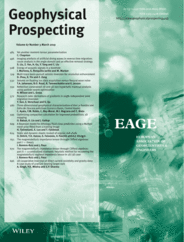
Full text loading...
 , Yossef H. Hatzor1
, Yossef H. Hatzor1 , Shimon Feinstein1, Vyacheslav Palchik1, Harold J. Vinegar1
, Shimon Feinstein1, Vyacheslav Palchik1, Harold J. Vinegar1
The elastic moduli and anisotropy of organic‐rich rocks are of great importance to geoengineering and geoprospecting of oil and gas reservoirs. In this paper, we probe into the static and dynamic moduli of the Ghareb–Mishash chalk through laboratory measurements and new analytical approaches. We define a new anisotropy parameter, ‘hydrostatic strain ratio’ (Ω), which describes the differential contraction of anisotropic rocks consequent to hydrostatic compression. Ω depends on the C11, C12, C13 and C33 stiffness constants of a transversely isotropic material, and therefore enables a unique insight into the anisotropic behaviour of TI rocks. Ω proves more sensitive to anisotropy within the weak anisotropy range, when compared with Thomsen's ε and γ parameters. We use Ω to derive static moduli from triaxial compression tests performed on a single specimen. This is done by novel employment of a hydrostatic‐deviatoric combination for transversely isotropic elastic stiffnesses. Dynamic moduli are obtained from acoustic velocities measurements. We find that the bedding‐normal velocities are described well by defining kerogen as the load‐supporting matrix in a Hashin–Shtrikman model (‘Hashin–Shtrikman (HS) kerogen’). The dynamic moduli of the Ghareb–Mishash chalk in dry conditions are significantly higher than the static moduli. The dynamic/static moduli ratio decreases from ∼4 to ∼2 with increasing kerogen content. Both the static and dynamic moduli decrease significantly with increasing porosity and kerogen content. The effect of porosity on them is two times stronger than the effect of kerogen.

Article metrics loading...

Full text loading...
References


Data & Media loading...

